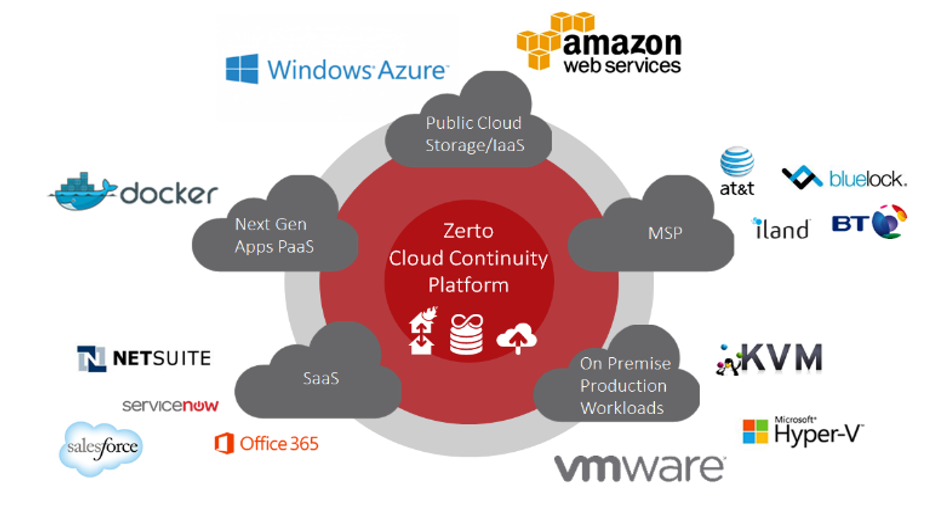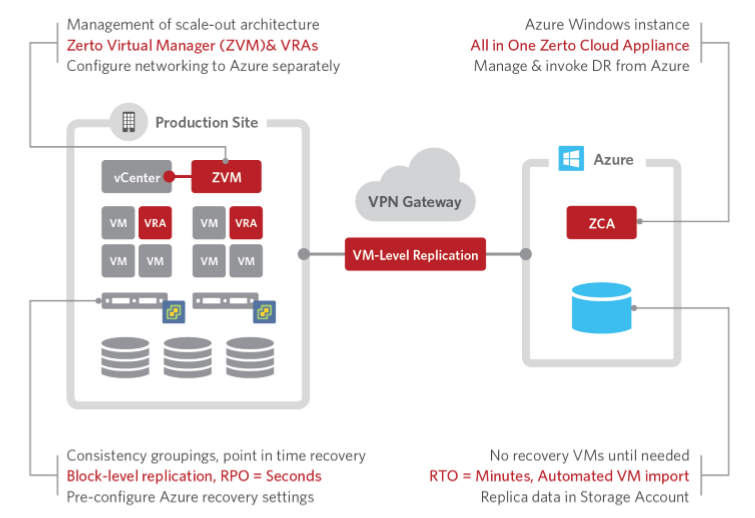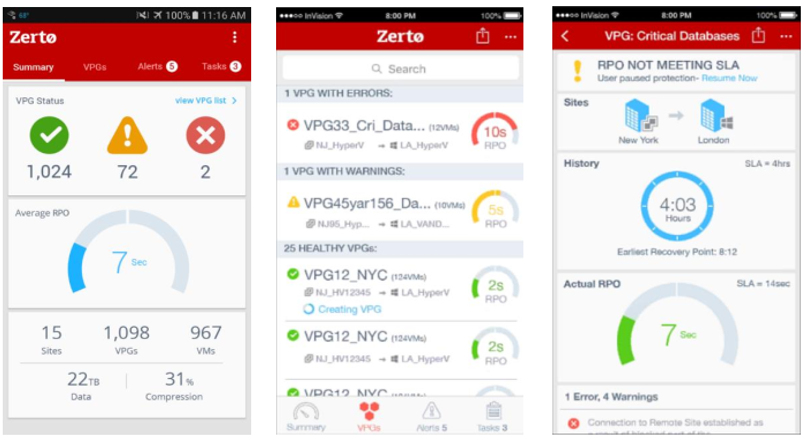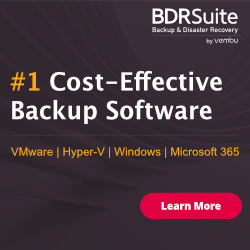
With the latest release of 5.0 Zerto continues to evolve beyond disaster recovery by enabling organizations to quickly recover from logical failures, file deletions, data corruptions and disasters while confidently embracing change to focus on business. New features include Disaster Recovery as a Service (DRaaS) to Microsoft Azure, One-To-Many replication for simultaneous local and remote replication of VMs enabling direct recovery to production, and a Zerto Mobile app for monitoring protection across multiple datacenters anywhere anytime from a single pane of glass.
Replication and Recovery to Microsoft Azure
Building on the continuing trend of businesses looking to utilize the cloud as a disaster recovery site, ZVR 5.0 will support Microsoft Azure as a target platform. A Zerto Cloud Appliance (ZCA) running in an Azure Windows D3 v2 VM is used to store the replica data in a storage account. ZVR 5.0 only creates the recovery VMs upon initiation of a failover, test or migration from either Zerto interface. Replication from both VMware vSphere and Microsoft Hyper-V environments is possible with RPOs in seconds, multi-VM consistent Virtual Protection Groups (VPGs) and fully automated RTOs in minutes. With support for DRaaS to Azure, ZVR 5.0 enables enterprise-class DR to the cloud with cost effective use of cloud economies of scale all while removing the significant overheads of having to manage and provision your own DR site altogether.
In Zerto Virtual Replication 5.0 the maximum journal retention time has been increased, enabling point-in-time recovery up to 1 month in the past, combined with compression and One-To-Many replication this now enables ZVR to replace short term VM backup solutions for data retention.
One -to-Many Replication
One-To-Many replication allows the simultaneous replication of a VM within the same site and to multiple remote sites. This includes replication from, between and to VMware vSphere and Microsoft Hyper-V environments as well as DRaaS to AWS & Azure. This feature works by simply allowing a VM to be placed into multiple VPGs, each with their own journal retention and Service Level Agreement (SLA) settings for maximum flexibility. There is no impact to the performance of the protected VM or the RPO enabling a multitude of use cases:
• Recover files & VMs directly to production or a recovery site
• Protect VMs to new datacenters during migrations
• Utilise the cloud for longer retention and DR
• Protect individual VMs locally to recover 1 VM from a remote multi-VM VPG
• Protect multiple application in 1 consistency group to a remote site for app boot ordering
Zerto Mobile
Uncertainty and a lack of confidence in the recovery process are problems that often stem from the difficulty of monitoring the protected environment. ZVR 5.0 solves this issue by introducing a new SaaS delivered mobile app, enabling the ability to remotely view the status of multiple Zerto Virtual Managers (ZVMs), Virtual Protection Groups (VPGs) and any alerts of running tasks from anywhere at any time, using a mobile phone. The app will be available for both Android and iOS platforms. All data is sent encrypted over the internet where it is stored in an encrypted cloud service and database back-end. Access is controlled by MyZerto enabling the secure management of employees requiring access to the app.
30-Day Journal History
For businesses that require longer retention of data, in ZVR 5.0 point-in-time recovery from the Journal will be extended up to 30 days in the past as the maximum history is extended from the previous 14-day setting. When coupled with journaling compression and the new One-toMany feature, each VM can have a different Journal history which can be configured on a per-VPG basis, enabling efficient usage of local storage or cheaper remote cloud storage. With compression there is no change to the recommended Journal sizing of 7-10%.
Improved Synchronization
In ZVR 5.0, improvements have been made to the replication engine that powers ZVR in order to parallelize synchronization operations within each disk. This results in improved initial synchronization times of up to 50%, enabling a faster time to protection. In addition, bitmap and delta synchronizations in scenarios where a significant amount of data change will also be improved.
Thanks to Kim Starbranch for sending invite for ZertoCON




